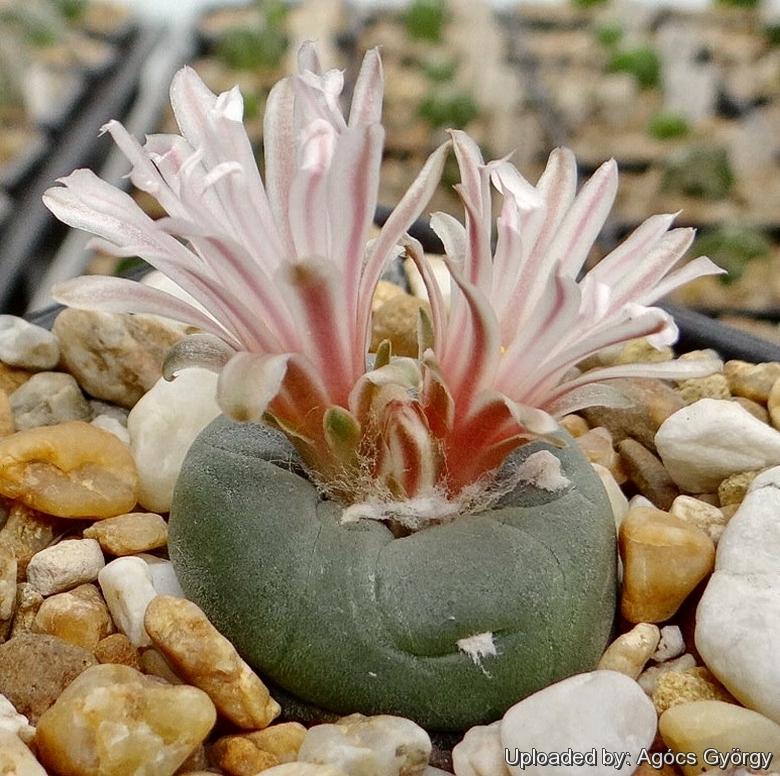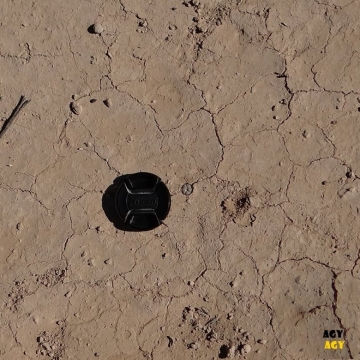
Lophophora alberto-vojtechii Photo by: Agócs György
Origin and Habitat: Northern San Luís Potosí, Mexico
Altitude: 1700 metres above sea level.
Habitat: They grow on alluvial sediments (as in the case of Lophophora koehresiiSN|1766]]SN|1759]]) in a very dry environment in a flat depression seasonally flooded and almost deprived of any visible vegetation.
Ecology: During the long extreme drought, characteristic of this area (practically throughout the year) the stems of Lophophora alberto-vojtechiiSN|1759]]SN|1766]] retract and drive under the dried mud into small cavities so the plants comes to be partially or completely buried, covered with dust and leaves which protect them from the sunlight. The plants are unnoticeable. It is only in wet periods that these plants become visible as they absorb moisture and swell. The stem enlarges, pushing the photosynthetic crown above the level of the ground and bloom some weeks after the rain. In the same locality grow Ariocarpus kotschoubeyanusSN|2127]]SN|2127]], Mammillaria coahuilensisSN|20805]]SN|15100]], Coryphanta hintonii, Ferocactus steinesii, Ferocactus hamatacanthus, Mammillaria heyderiSN|15100]]SN|20805]]i, Echinocereus enneacanthusSN|7930]]SN|7930]], Ancistrocactus uncinatusSN|3476]]SN|3476]] and Opuntia bulbispinaSN|9853]]SN|9853]].
Synonyms:
Description: Lophophora alberto-vojtechiiSN|1766]]SN|1766]] is a fascinating very cryptic, geophytic plant with a swollen subterranean root, characterized by its distinctively small size. It is by far the littlest lophophora, adult plants typically reaching just about 2 cm in diameter.
Root: Turnip-shaped, succulent, smooth, off-white to creamy yellow, solitary (or few branched) approximatively 30 mm long and 16 mm in diameter where it merges the subterranean stem.
Stem Greyish green often blushed of mauve, for the most part buried in the soil, apex barely emerging from the ground flat to somewhat convex, 10 to 50 mm in diameter (but usually less than 18 mm wide); the underground portion of the stem is cylindrical 25 or more mm long.
Ribs: Typically 5 often indistinct (occasionally up to 8)
Areoles: Not easily seen, with few wool only in new growth near apex, but wool drops off easily, so plants may appear bare.
Flowers: Several in the centre of the stem 15-35 mm wide, often larger than the diameter of the plant, tepals and style long, filaments white with yellowish orange anthers; style white; stigma yellowish (occasionally white to yellowish or pinkish). The tepals are unusually rounded at the ends, white to light pink with a distinctive darker stripe (brownish, salmon or darker violet pink) on the adaxial surface, but also visible in the outer side.
Blooming period: It produces several buds at the same time but they do not all open at once. Many plants start flowering when they are only 10 mm in diameter.
Fruit: Dry at maturity, round to more or less claviform, whitish, yellowish or pinkish.
Seeds: Black, round, 1.15-1.45 mm long and 1.0-1.45 mm wide.
Notes: The characteristic of the flowers suggest that Lophophora alberto-vojtechiiSN|1759]]SN|1766]] is related to Lophophora koehresiiSN|1766]]SN|1759]], but unlike L. koehresii the flowers are more rounded (in some cases perfectly round).
Bibliography: Maor references and further lectures
1) Jaroslav Šnicer, Jaroslav Bohata, Vojtěch Myšák "Lophopbora alberto-voitechii, J. Bohata, V Mysak & J. Snicer: una nuova preziosa miniatura nel genere Lophophora — an exquisite new miniature from the genus Lophopbora" in Cactus & Co. 2(12): 105-117, 2008
2) Jaroslav Šnicer, Jaroslav Bohata, Vojtěch Myšák "The littlest Lophophora- L. alberto-vojtechii" in Cactus and Succulents Journal, volume 81, number 6, pages 294-300, 2009.
 During the long extreme drought the stems of this plant retract and drive under the dried mud into small cavities. Photo by: Agócs György
During the long extreme drought the stems of this plant retract and drive under the dried mud into small cavities. Photo by: Agócs György Lophophora alberto-vojtechii Photo by: Valentino Vallicelli
Lophophora alberto-vojtechii Photo by: Valentino Vallicelli Lophophora alberto-vojtechii Photo by: Prof. Ilham Alakbarov
Lophophora alberto-vojtechii Photo by: Prof. Ilham AlakbarovSend a photo of this plant.The gallery now contains thousands of pictures, however it is possible to do even more. We are, of course, seeking photos of species not yet shown in the gallery but not only that, we are also looking for better pictures than those already present.
Read More... Cultivation and Propagation: Slow growing, it requires half-shade in summer, full sun the rest of the year. Grow it in a narrow and deep container to accommodate the tap root. They are very rot prone, so use highly gritty compost with much drainage.
Waterings should be rather infrequent, to keep the plant compact and not to become excessively elongated and unnatural in appearance. Watering it properly is often difficult, because this plant tends to crack open or rot if over-watered. The fact that the plant retracts into the soil and assumes a grey-green colouring between waterings is perfectly natural, and doesn’t cause any damage. Like other arid zone cacti, they require a dry and cool over-wintering; otherwise they may succumb to rot. This also promotes flowering. Assure good ventilation.
Propagation: Seeds. Seeds should be sown in spring, in sterile cacti mix. Cover with a humidity dome or plastic wrap and leave in a warm spot in 50-75% shade. Fluctuating temperatures are best (i.e. high day temperature and low night temperature), as they simulate the desert environment. Keep constantly humid, as seedlings cannot survive if too dry. Seedlings will emerge in 7-21 days and can be grown in the same environment for a number of months. Mulch with thin layer of small quartz gravel (1-2 mm diameter). This helps them stay upright, hinders algae growth and regulates moisture. As they get older, the watering can become less frequent. Potting up can be done when 5-8 mm in diameter.













